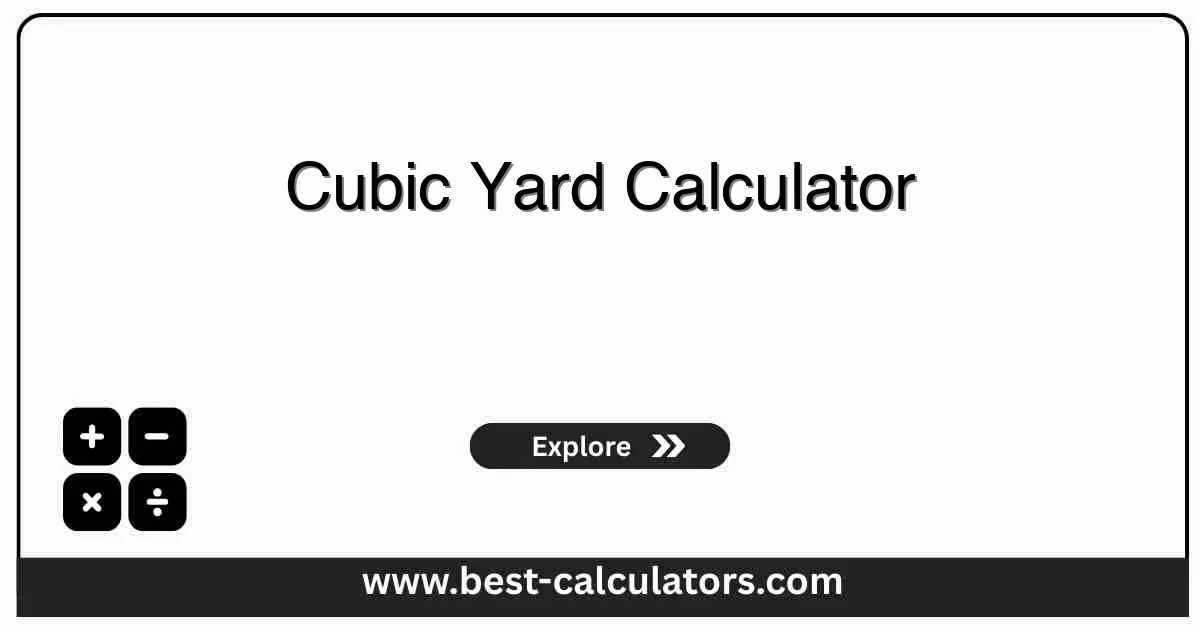Cubic Yard Calculator - Calculate Volume for Construction Materials
Calculate cubic yards for soil, mulch, concrete, and other materials with volume conversion and project estimation features.
Cubic Yard Calculator
Results
What is a Cubic Yard Calculator?
A Cubic Yard Calculator is a construction tool that calculates the volume of materials needed for your projects. It converts length, width, and height/depth measurements into cubic yards, the standard unit for bulk material ordering.
This calculator is essential for:
- Concrete Projects - Accurate volume calculations for foundations and slabs
- Landscaping - Soil, mulch, and gravel volume estimation
- Material Ordering - Precise quantities for cost-effective purchasing
- Project Planning - Budget and timeline optimization
Related Construction Calculators:
- For concrete projects, use our Concrete Calculator to determine exact cubic yards needed for foundations and slabs
- Calculate crushed stone requirements with our Crushed Stone Calculator for driveways and base materials
- Planning a deck foundation? Our Deck Footing Calculator helps estimate concrete volume in cubic yards
How the Calculator Works
The calculation uses this formula:
Where:
- Length = Length in feet
- Width = Width in feet
- Height = Height/depth in feet
The waste factor adds extra material for:
- Cutting and trimming waste
- Material settling and compaction
- Irregular surface variations
Key Concepts Explained
Cubic Yard vs Cubic Foot
1 cubic yard = 27 cubic feet. Cubic yards are used for bulk materials because they represent more manageable quantities for construction projects.
Material Density
Different materials have different densities. The same cubic yard volume will weigh very differently for soil vs concrete vs mulch.
How to Use This Calculator
Enter Dimensions
Input length, width, and height/depth in feet
Select Material
Choose material type for price estimation (optional)
Add Waste Factor
Include percentage for waste and settling
Get Results
View cubic yards, volume, and total cost
Benefits of Using This Calculator
- • Accurate Material Ordering: Know exactly how much material to purchase.
- • Cost Savings: Avoid over-ordering expensive materials.
- • Waste Reduction: Account for waste factors in your planning.
- • Professional Results: Ensure proper material quantities for quality work.
Factors That Affect Your Results
1. Material Compaction
Materials like soil and gravel compact over time. Add extra volume to account for settling.
2. Surface Irregularities
Real-world surfaces aren't perfectly flat. Consider adding extra depth for uneven areas.
3. Material Type
Different materials have different characteristics that affect final volume requirements.
Common Mistakes to Avoid
❌ Confusing Cubic Feet and Cubic Yards
One cubic yard equals 27 cubic feet. Ordering in wrong units can result in massive shortages or expensive overages. Always verify the unit of measure with your supplier before ordering.
❌ Not Adding Waste Factor
Excavation isn't perfect, and materials compact. Ordering exact calculations leaves no margin for error. Always add 10-15% waste factor for concrete, soil, and gravel projects.
❌ Measuring in Mixed Units
Mixing feet and inches without converting leads to calculation errors. Always convert all measurements to the same unit (preferably feet) before calculating cubic yards.
❌ Forgetting Depth Variations
Uneven ground or sloped areas require average depth calculations. Measuring at one point and assuming uniform depth can cause major shortages or waste. Measure multiple points and average.
❌ Not Considering Delivery Minimums
Many suppliers have minimum delivery requirements (often 10 cubic yards). Small projects may need to pick up material yourself or pay premium delivery fees. Check minimums before planning.

Frequently Asked Questions (FAQ)
Q: What is a cubic yard?
A: A cubic yard is a volume measurement equal to 27 cubic feet (3ft × 3ft × 3ft), commonly used for bulk construction materials.
Q: How do I calculate cubic yards?
A: Multiply length × width × height/depth in feet. For irregular shapes, break them into smaller rectangles and add the volumes together.
Q: What's the difference between cubic feet and cubic yards?
A: 1 cubic yard = 27 cubic feet. Cubic yards are preferred for construction because they represent more practical quantities.
Q: When should I use cubic yards?
A: Use cubic yards for bulk materials like soil, concrete, gravel, and mulch when ordering from suppliers who sell in cubic yard quantities.